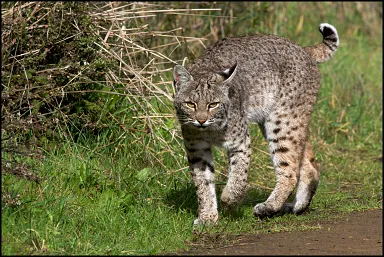
Bobcat Photo Courtesy of Trish Carney.
Bobcat
Species Facts
The bobcat’s name comes from its bobbed tail. This cat is medium-sized, with long, muscular legs, a small head, and the signature tail stub. The large ears are tipped with a short tuft of black hairs. The cat’s thick and soft fur varies in color from buff, brown, reddish or yellowish brown to light gray, and is streaked or spotted with black or dark brown. This gives the cat a mottled appearance. As with other cat species, males are heavier and longer than females.
- Scientific Designation: Lynx rufus
- Related Project: Bay Area Bobcat Project
- Endangered Status: Least Concern (LC)
- Lifespan: Up to 12 years (wild)
- Weight: 4-15 kg
- Length: 66-104 cm
- Shoulder Height: 1-1.5 ft
- Tail Length: 10-18 cm
Habitat and Diet
Bobcats share many habitats with other carnivores. Coyotes and pumas are known to occasionally kill bobcats and indirect evidence suggests that these two predators limit bobcat distribution and density. This species is primarily active in the few hours before and after sunset and sunrise. In many parts of its range, the solitary bobcat specializes in hunting lagomorphs (rabbits and hares), but will also eat rodents and deer.

Species Distribution
The species’ distribution ranges from southern Canada, southward through much of the United States, and into Central Mexico. Within this extensive range, bobcats live in a wide variety of habitats (swamps, boreal coniferous forest, and mixed hardwood forest). Although the bobcat is a habitat generalist, it prefers areas with dense cover or uneven, broken terrain. The preferred terrain provides concealment for escape and privacy, as well as relief from temperature and wind extremes.
Distribution map courtesy of IUCN (International Union for Conservation of Nature), compiled in 2016.

A wild bobcat in Marin County. Photo courtesy of and copyright Trish Carney. All rights reserved. Used with permission.
Threats to the Bobcat
This cat is currently classified as Least Concern (LC) by the International Union for Conservation of Nature (IUCN) and protected under appendix I of the Convention on International Trade in Endangered Species (CITES). The main threats to the bobcat are hunting by humans and habitat loss.
Want to help us research and conserve this species?
Felidae Conservation Fund helps researchers around the world study and protect felids of all sizes.
Make sure you write a comment with "Bobcat" so we can designate 100% of your donation to go to protecting this species.
Do You Have 2-4 Hours A Month To Preserve Your Local Ecosystem?
Our volunteers are the driving force behind making true change in ecosystem health and wild cat conservation. Some like to volunteer in the field, others help us maintain our online presence, and some work with events. With just a few hours a month, you can make a difference, too.
Make A Difference Right Now
As a 501(c)3 nonprofit, our work is only possible because of generous donors like you.
More than 90% of your donation will go directly to our groundbreaking research, outreach, and education programs.
This is where true change starts. If you’d like to be a part of it, make a donation to Felidae Conservation Fund today:
Or,
